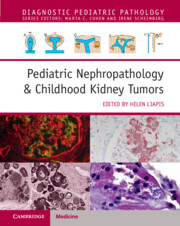Book contents
- Pediatric Nephropathology & Childhood Kidney Tumors
- Diagnostic Pediatric Pathology
- Pediatric Nephropathology & Childhood Kidney Tumors
- Copyright page
- Dedication
- Contents
- Contributors
- Preface
- Section 1 Normal and Abnormal Human Kidney Development
- Section 2 Glomerular Diseases
- Chapter 3 Idiopathic and Hereditary Proteinuric Glomerular Diseases
- Chapter 4 Haematuric Glomerular Diseases (Collagenopathies)
- Chapter 5 Immune Complex Mediated Glomerular Diseases
- Chapter 6 Inherited Metabolic Diseases Affecting the Kidney
- Chapter 7 Glomerular Diseases with Fibrillary Deposits
- Chapter 8 Mitochondrial Diseases in the Pediatric Kidney
- Section 3 Tubulointerstitial Diseases
- Section 4 Vascular Diseases
- Section 5 Infectious Diseases
- Section 6 Cystic Diseases
- Section 7 Solid Tumors of the Kidney
- Section 8 Transplant Pathology of the Kidney
- Index
- References
Chapter 4 - Haematuric Glomerular Diseases (Collagenopathies)
from Section 2 - Glomerular Diseases
Published online by Cambridge University Press: 10 August 2023
- Pediatric Nephropathology & Childhood Kidney Tumors
- Diagnostic Pediatric Pathology
- Pediatric Nephropathology & Childhood Kidney Tumors
- Copyright page
- Dedication
- Contents
- Contributors
- Preface
- Section 1 Normal and Abnormal Human Kidney Development
- Section 2 Glomerular Diseases
- Chapter 3 Idiopathic and Hereditary Proteinuric Glomerular Diseases
- Chapter 4 Haematuric Glomerular Diseases (Collagenopathies)
- Chapter 5 Immune Complex Mediated Glomerular Diseases
- Chapter 6 Inherited Metabolic Diseases Affecting the Kidney
- Chapter 7 Glomerular Diseases with Fibrillary Deposits
- Chapter 8 Mitochondrial Diseases in the Pediatric Kidney
- Section 3 Tubulointerstitial Diseases
- Section 4 Vascular Diseases
- Section 5 Infectious Diseases
- Section 6 Cystic Diseases
- Section 7 Solid Tumors of the Kidney
- Section 8 Transplant Pathology of the Kidney
- Index
- References
Summary
This chapter will present clinical and histopathologic findings, pathophysiology and molecular genetics of glomerular basement membrane (GBM) diseases presenting primarily with hematuria. The GBM is a complex structure mainly composed of collagen IV in its mature form, but also other components such as nidogen, agrin and perlecan. Diseases of collagen IV disorders include Alport syndrome and thin basement membrane disease, Pierson syndrome, caused by mutations in the LAMB2 gene, nail–patella syndrome caused by LMX1B mutations with collagen type III accumulation that requires unmasking, and type III collagenopathy characterised by increased type III collagen in the GBM and the glomerular mesangium. Current and future therapies will also be discussed
Keywords
- Type
- Chapter
- Information
- Pediatric Nephropathology & Childhood Kidney Tumors , pp. 56 - 86Publisher: Cambridge University PressPrint publication year: 2023

